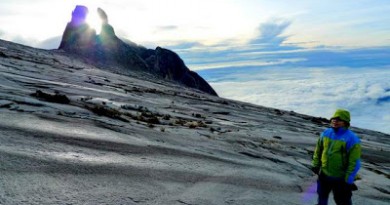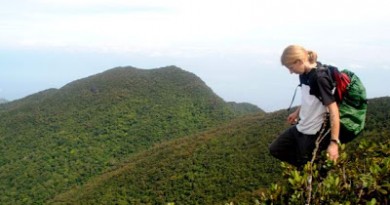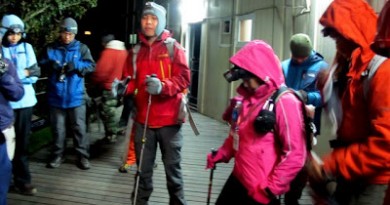Altitude sickness in Mt. Kinabalu: How to avoid it and maximize your chances of reaching the summit
by Gideon Lasco, MD
 This is an article belonging to the ‘climb health‘ category in PinoyMountaineer. The information provided in this article is based on research and clinical experience and are not meant as a substitute to actual medical advice and healthcare.
This is an article belonging to the ‘climb health‘ category in PinoyMountaineer. The information provided in this article is based on research and clinical experience and are not meant as a substitute to actual medical advice and healthcare.
Just two hours from Manila by plane, Mt. Kinabalu is usually the Filipino hiker’s first encounter with high altitude. It is the closest 4000+ meter mountain to the Philippines, and every year, around 200-400 Pinoys head to its lofty granite slopes.
By high altitude, I mean elevations greater than 10000 feet or 3000 meters above sea level. Consequently, Kinabalu is also the first instance where there s a risk of altitude sickness, also known as acute mountain sickness or AMS.
Thus, I feel that an article on altitude sickness will be beneficial. What I will write here is a matter of opinion, drawing from my experiences in Mt. Kinabalu, which I have successfully climbed thrice (2008, 2011, 2012), each time as expedition leader, and concurrently, expedition doctor.
The first thing you need to know about altitude sickness is that it can happen to anyone, regardless of physical strength, training, age, or sex. So you cannot predict or anticipate it. Moreover, the occurrence of altitude sickness increases as altitude increases. Kinabalu is still relatively low of you compare it with Mt. Kilimanjaro, Everest Base Camp, or Annapurna Circuit.
In Mt. Kinabalu, my experience of hiking with a total of 67 Filipinos is that 20-30% develop mild symptoms of AMS (mild headache); 5-10% develop moderate symptoms. I have not seen severe symptoms, such as pulmonary edema or cerebral edema, but the moderate symptoms prevented some of the hikers from reaching the summit.
Symptoms usually begin set in at Layang-Layang hut, which is around the height of Mt. Amuyao, and at Laban Rata, people begin to feel headaches, but many of these cases resolve in the evening. For others, the symptoms happen during the summit assault.
TIPS FOR AVOIDING ALTITUDE SICKNESS IN MT. KINABALU
1. Don’t ascend to Laban Rata too fast. Between Timpohon Gate, which is 1800m, and Laban Rata, the 1400-meter gain in a single day can prove too rapid, especially if you factor in the origin of participants just the day before: Manila, which is at sea level. I have a friend who’s a marathoner and trail runner; he breezed his way up Laban Rata, but began to have a bad headache after.
2 . Hydrate at Laban Rata – take advantage of the free Sabah tea in the buffet dinner. Across the world, drinking tea is known to help people acclimatize. Leo Oracion always advises me to hydrate in evening, and before the climb. However, do not overdo it. Overhydration can also be harmful.
3. Try to get some sleep in Laban Rata. Of the people I guided in Kinabalu, those who didn’t make it have one thing in common: they didn’t get sleep in Laban Rata.
4. If you are feeling mild symptoms such as a slight headache, it’s not really a reason to turn back. You can still proceed. However, moderate symptoms such as a severe headache, vomiting, and dizziness. Importantly, difficulty of breathing, or sudden onset of a cough accompanied by a wheezing or crackling sound while breathing, is a reason to stop the ascent.
5. Do not sleep, take a nap, or lie down while performing the summit assault. Do not be pressured to keep up with the pace of your companions, or of other people. The rule of trekking in high altitude is this: It’s best to take it slowly.
6. Just bring the essentials during the assault. A heavy bag can make breathing more difficult, by adding more burden to muscles of breathing. Use your waist strap. Remember that there are only a few things you will need up the summit: some water, a bar or two of chocolate or other high- energy food, camera.
7. Acetazolamide (Diamox), although proven to hasten acclimatization, is not necessary in Mt. Kinabalu. Since it has side effects that can also affect your hiking, it must only be administered by an experienced medic. Almost everyone successfully reaches the summit without needing it. I do not recommend it for routine use in Mt. Kinabalu. Moreover, for those who have ambitions beyond Kinabalu, it would be nice to see your body’s natural ability to adapt to high altitude without the aid of medications.
8. For those who want to make another attempt up Kinabalu, and for those who wish to maximize their chances of summiting, acclimatization is suggested. Climbing Mt. Pulag a week or two before the hike can be a good idea. Staying overnight at the Mt. Kinabalu Park HQ is also a beneficial strategy.
9. Taking the hike seriously is also a good perspective. As experienced hikers always say: never underestimate a mountain. No matter how often people say that Mt. Kinabalu is “commercialized”, it is still a challenging hike. Ascending 2300 meters in two days is not a easy task. And if you are not prepared, you will experience difficulty of breathing even if it’s not altitude sickness!
Conclusion: Mt. Kinabalu is a good first stab at high altitude; it is a rewarding, fairly accessible hike, and I highly recommend it. Following the steps I listed above will help in maximizing your chances at what I call the three S’s of success: safety, summit, and smiles.






Leave a Reply
2 Comments on "Altitude sickness in Mt. Kinabalu: How to avoid it and maximize your chances of reaching the summit"
Thanks a bunch for the tips Sir Gid (c",)
I'm one of those 20%-30% of the Filipinos who experienced the moderate symptoms. Also had difficulties in breathing beginning from some 3000+ MASL.
Really, it's not a good thing to rush the ascent. Take your time and you'll eventually make it without a headache, literally and figuratively 😀
Thanks for the useful tips. Will be heading up to the summit of Pulag again this November so it's nice to read up on more climbing info. Only been to the senior summit once although I've done the junior summit several times already. This time though I'll be bringing my own pack unlike last time where we just left our stuff at the village which made the trek considerably easier.